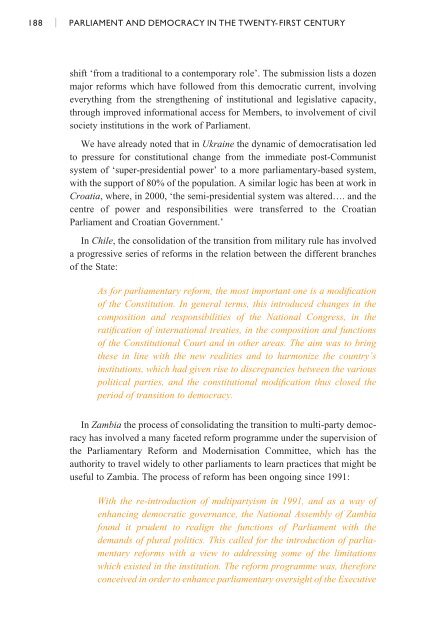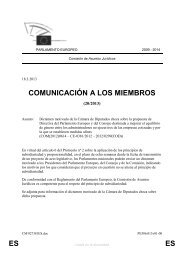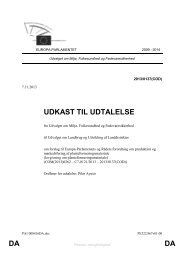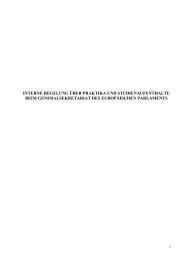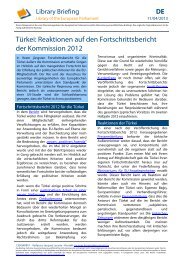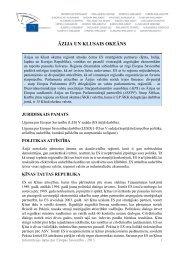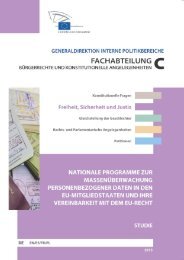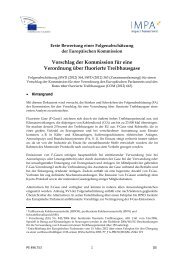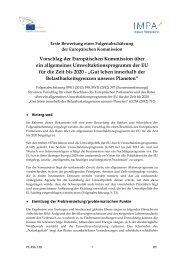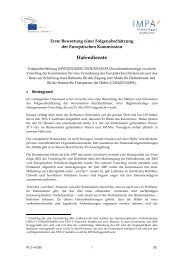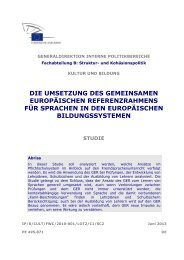PARLIAMENT AND DEMOCRACY - Inter-Parliamentary Union
PARLIAMENT AND DEMOCRACY - Inter-Parliamentary Union
PARLIAMENT AND DEMOCRACY - Inter-Parliamentary Union
Create successful ePaper yourself
Turn your PDF publications into a flip-book with our unique Google optimized e-Paper software.
188 I <strong>PARLIAMENT</strong> <strong>AND</strong> <strong>DEMOCRACY</strong> IN THE TWENTY-FIRST CENTURY<br />
shift ‘from a traditional to a contemporary role’. The submission lists a dozen<br />
major reforms which have followed from this democratic current, involving<br />
everything from the strengthening of institutional and legislative capacity,<br />
through improved informational access for Members, to involvement of civil<br />
society institutions in the work of Parliament.<br />
We have already noted that in Ukraine the dynamic of democratisation led<br />
to pressure for constitutional change from the immediate post-Communist<br />
system of ‘super-presidential power’ to a more parliamentary-based system,<br />
with the support of 80% of the population. A similar logic has been at work in<br />
Croatia, where, in 2000, ‘the semi-presidential system was altered…. and the<br />
centre of power and responsibilities were transferred to the Croatian<br />
Parliament and Croatian Government.’<br />
In Chile, the consolidation of the transition from military rule has involved<br />
a progressive series of reforms in the relation between the different branches<br />
of the State:<br />
As for parliamentary reform, the most important one is a modification<br />
of the Constitution. In general terms, this introduced changes in the<br />
composition and responsibilities of the National Congress, in the<br />
ratification of international treaties, in the composition and functions<br />
of the Constitutional Court and in other areas. The aim was to bring<br />
these in line with the new realities and to harmonize the country’s<br />
institutions, which had given rise to discrepancies between the various<br />
political parties, and the constitutional modification thus closed the<br />
period of transition to democracy.<br />
In Zambia the process of consolidating the transition to multi-party democracy<br />
has involved a many faceted reform programme under the supervision of<br />
the <strong>Parliamentary</strong> Reform and Modernisation Committee, which has the<br />
authority to travel widely to other parliaments to learn practices that might be<br />
useful to Zambia. The process of reform has been ongoing since 1991:<br />
With the re-introduction of multipartyism in 1991, and as a way of<br />
enhancing democratic governance, the National Assembly of Zambia<br />
found it prudent to realign the functions of Parliament with the<br />
demands of plural politics. This called for the introduction of parliamentary<br />
reforms with a view to addressing some of the limitations<br />
which existed in the institution. The reform programme was, therefore<br />
conceived in order to enhance parliamentary oversight of the Executive


